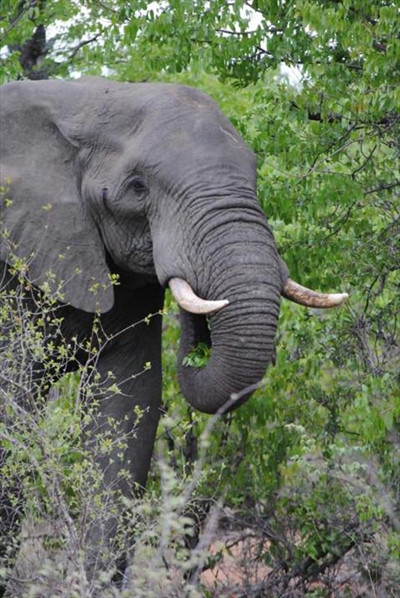| Issue 29 |
| A Few Steps for Elephants, a Giant Leap for Conservation | |
| Malawi's human-assisted elephant migration provides the best chance of a long-term and sustainable future for these endangered animals | |
|
|
 (Photos by Jo Kromberg)
The recent CITES (the Convention on International Trade in Endangered Species of Wild Fauna and Flora) COP 17 conference held in South Africa in September has again placed the spotlight on the most desperately endangered fauna and flora worldwide, but especially in Africa. Despite a ban on the international trade in ivory, African elephants are still being poached in large numbers. Tens of thousands of elephants are being killed every year for their ivory tusks.
The ivory is often carved into ornaments and jewelry with Asia still being the biggest consumer market for such products, according to WWF Global. The ban on international trade was introduced in 1989 by CITES after years of unprecedented poaching. In the 1980s, an estimated 100,000 elephants were being killed per year and up to 80 percent of herds were lost in some regions. The ban allowed some populations to recover, especially where elephants were adequately protected. But there has been an upsurge in poaching and illegal ivory trafficking in recent years, driven by increasing demand in Asia, which has led to steep declines in forest elephant numbers and some savannah elephant populations. Insufficient anti-poaching capacity, weak law enforcement and corruption undermine efforts to stop the poaching and trafficking in some countries.
Malawi translocates elephants Luckily, a non-profit organization called African Parks embarked on a historic and massive undertaking a couple of months ago. This led, in July, to the start of one of the world's largest and most significant elephant translocations in Malawi, a country located in south-eastern Africa. Since then, 150 elephants have made the 350 km journey to their new home, Nkhotakota Wildlife Reserve. In total, up to 500 elephants have been translocated from Liwonde National Park and Majete Wildlife Reserve, in southern Malawi to their new home not far from the famous Lake Malawi in central Malawi. Nkhotakota is only 200 km from Lilongwe, Malawi's capital, and 378 km from Blantyre, Malawi's largest city so access to the area for tourists will be relatively easy. In addition to the elephants, thousands of other animals including sable, waterbuck, zebra, kudu, eland and warthogs are also being translocated; all with the goal of repopulating Nkhotakota and restoring it to its former glory after years of neglect and poaching. With anti-poaching measures, fencing and local conservation education as integral parts of African Parks' rehabilitation of Nkhotakota, the newly-arrived animals will have a much safer and more secure new home. The first elephants to enter the Reserve were a family of nine individuals, but families of up to 20-25 can be moved at a time. So far all the elephants are doing well and staying within the perimeter fencing. African Parks, who are leading the translocation, plan to collar a total of 35 of these first 250 elephants in order to monitor them in their vast new home. Collars will be attached to 10 bulls and the rest to matriarchs. The operation has two objectives: to relieve pressure from the elephant surplus in Liwonde and Majete, and to restock Nkhotakota, which supported more than 1,500 elephants 20 years ago, but today has fewer than 100. Liwonde and Majete are source populations for elephants and are at or nearing capacity (with populations of 800 and 400 elephants respectively), resulting in habitat degradation and high levels of human-wildlife conflict. As Malawi is a densely-populated, agro-based country, no ecological corridors exist to allow for natural migration. The "500 Elephants" initiative is a human-assisted migration providing the best chance of a long-term and sustainable future for these elephants. This is an extremely hopeful story for conservation, elephants and particularly for Malawi. Journalist Sue Watt, who has been given special access to the project, said: "I watched the elephants being darted and captured in Liwonde, then was fortunate to see the first group walking into their new home in Nkhotakota the following day. It's a very complex operation and I have been hugely impressed, not just at the professionalism of the team but their compassion and commitment—it's such an inspiring project."
Complete destination The future for Nkhotakota looks bright—the next 12 months will see a repopulated park both with elephants and other game species, a premier elephant sanctuary for Malawi and tourism hotspot for the country in the coming years. Add this to the Big-Five Majete Wildlife Reserve and the stunning Liwonde National Park and Malawi is set to become one of the most complete destinations in Africa—lake, landscape, culture and now wildlife experiences of the highest quality. Since 2003 African Parks has, in partnership with the Malawi government, managed Majete Wildlife Reserve, a partnership that has seen the reserve restored and restocked with 2,500 animals including the Big-Five. Majete has been a great success and is now one of Malawi's premier wildlife sanctuaries, conserving and protecting more than 8,800 animals. With the addition of Liwonde National Park and Nkhotakota Wildlife Reserve in 2015, African Parks now manages three of Malawi's nine protected areas and with goals to match all that has been achieved in Majete, African Parks are transforming the wildlife of the country. More about African Parks African Parks is a non-profit conservation organization that takes on the complete responsibility for the rehabilitation and long-term management of national parks in partnership with governments and local communities. African Parks manages 10 national parks and protected areas in seven countries covering six million hectares: Malawi, Zambia, Central African Republic, The Democratic Republic of Congo, the Republic of Congo, Rwanda and Chad. To learn more, please visit To learn more about the translocation and how you move 500 elephants, as well as to get current updates, please visit |
|
||||||||||||||||||||||||||||||
|
